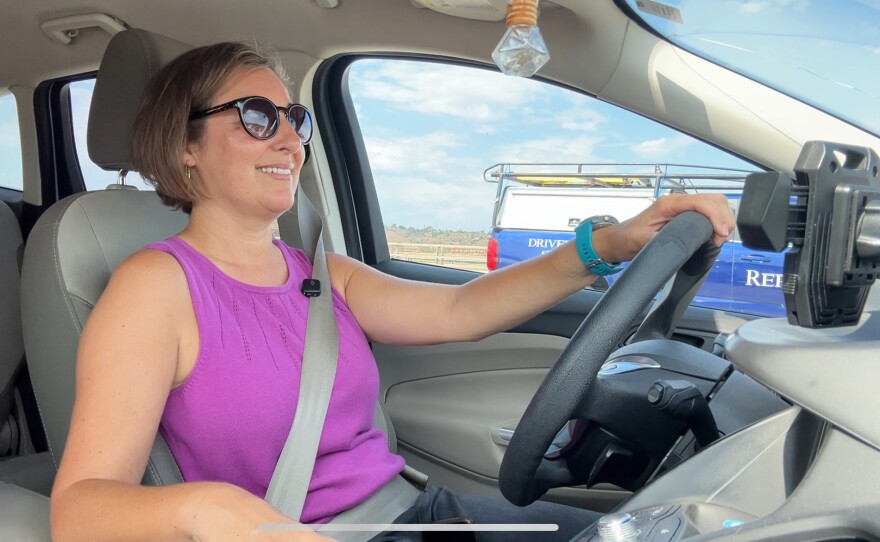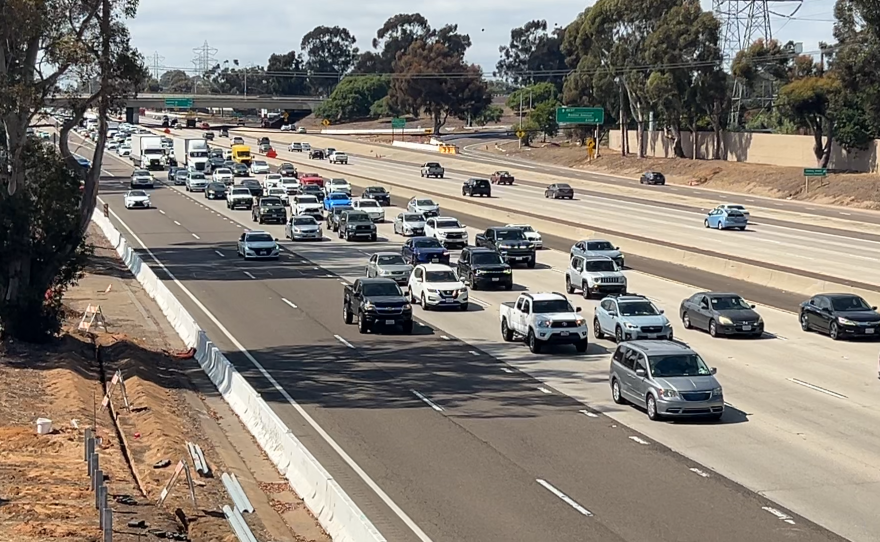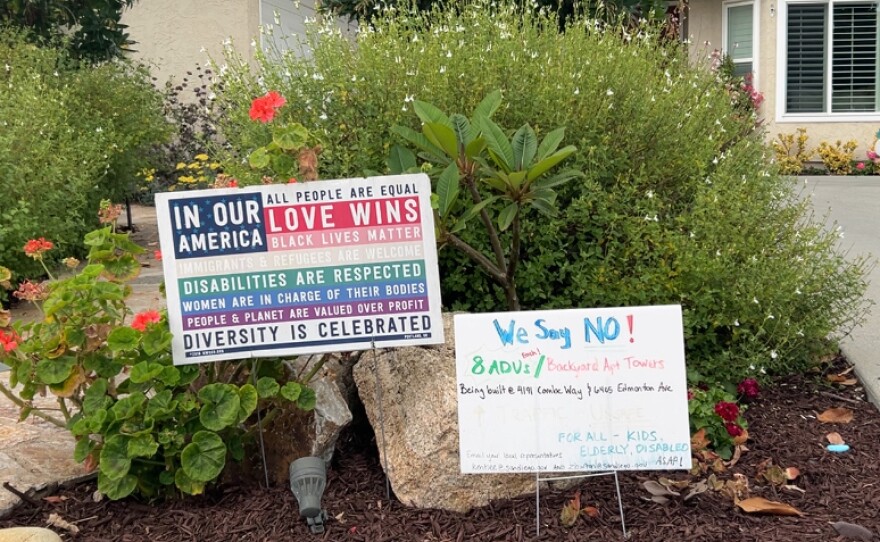Take a trip through certain neighborhoods in San Diego County and it’s clear: there are a lot of new homes being built. In fact, 96,859 permits for homes were issued from 2018 to 2024, according to state housing data.
But those homes are not always built in areas close to jobs, public transit or other resources.
One place where this is especially clear is the county’s largest job center: the UTC and Sorrento Valley area.
It has the most employees in the region. Think about all the workers at UC San Diego, biotech and tech companies, and the multiple hospitals. And it has new transportation options with the Blue Line trolley.
But the area has seen very few permits issued for new homes. Just 336 permits in the last six years, less than 1% of the total across the county.
That means workers in the area have a choice between long commutes with traffic on Interstate 805, or the high priced homes in the area, where the average home costs about $1 million, and the average rent is over $3,000.
A new city plan is aiming to build more homes in the area, allowing more people to live near their jobs. But not everyone is happy with the change.
The problem: traffic
San Diego’s traffic patterns can tell you a lot about housing.
Generally, congestion forms when too many drivers are going to the same place all at once. That happens every day on I-805.
In the morning, from Chula Vista to La Jolla Village Drive, the northbound side slows to a crawl. In the evening, traffic on the southbound side is usually worse.
“I’ll tell you, it sucks driving in traffic,“ said Ashley Harbecke, a teacher at University City High School.
She lives in North Park. During the school year, she drives up the 805 in the morning, and back down in the afternoon.
“Even though I’m done pretty early as a teacher, at 3:36 is when our bell rings so I’m out by 3:45, I won’t get home until about 5 o’clock because I’m stuck in so much traffic,” Harbecke said.
And she’s clearly not alone. The traffic she’s stuck in is made up of thousands of drivers in the same boat.
“We have a big separation between where the job centers are … and where people live,” said Colin Parent, CEO of the advocacy group Circulate San Diego.

Traffic patterns used to follow a formula: commuters from the suburbs would head downtown for work in the morning, and then drive back home in the evening.
But over the past few decades that pattern has changed in San Diego County, as job centers outside of the downtown area have grown to surpass the urban core.
Sorrento Valley is the largest locus of jobs in the county, with over 169,000 employees, according to data from the San Diego Association of Governments (SANDAG). The data defines the area as stretching from UCSD to UTC to Sorrento Mesa and Sorrento Valley, and includes Torrey Hills.
Kearny Mesa is second, with over 125,000 employees, and downtown is now third, with just over 104,000. But downtown permitted 11,000 homes in the last six years, 11% of the total across the region.
Sorrento Valley has only about 20,000 homes total, according to SANDAG. That’s not nearly enough to house all those workers.
“One (reason) is that, in some of these job centers, historically, you weren’t even allowed to build housing,“ Parent said.
That’s one reason why the number of permits in the area was so low for the past six years. The zoning laws didn’t allow for very many new homes.
The lack of new housing means the vast majority of workers in the area don’t live where they work, and instead have to commute — creating the traffic nightmare on I-805.
Long commutes and pollution
SANDAG data shows that 78% of workers in Sorrento Valley drive to work alone.
About 13% of workers carpool, and 10% of employees in the region walk, bike or take public transportation to work.
The average distance employees drive is more than 14 miles. In traffic on I-805, that can take a long time.
“If I am awesome and I leave at 7 a.m., it’ll take me 20 minutes,” Harbecke said. “If I leave at 7:30 or 7:45 though, it could take up to 30 to 45 minutes.“
Meanwhile, people who work downtown are more likely to get to work another way besides driving.
While 53% still drive alone, more than 20% take transit, and another 14% walk or ride a bike.
And the average time spent commuting to work is 23% less for workers downtown than for workers in Sorrento Valley.
All that time spent in a car isn’t just bad for the environment.
“It’s really painful,” Parent said. “You have to spend a lot of time stressed out, in your car. And that means you have less time at home, less time with your family … and that’s just a real drain on people.”

Harbecke said her commute affects every part of her life.
“What events I’m going to plan to do after work, if I can have time to hang out with people, or … go catch a happy hour or something,” she said. “I miss out on some of those things.”
It also means pollution.
“You have the environmental pollution of living close to the freeway,” said Chris Roberts from the environmental group San Diego 350. “Nitric oxide and particulates. But then of course, from burning fossil fuels, all the carbon.”
Transportation remains the largest source of greenhouse gasses in the county, representing more than 50% of these emissions, according to SANDAG. But Sorrento Valley has plenty of transit options. The Blue Line extension that opened in 2021 created a rail connection to downtown from UCSD and UTC.
The Metropolitan Transit System (MTS) reported last year that three bus routes in the area surpassed the million-rider mark in fiscal year 2024.
“That area actually is one of the most transit dense, and has some of the most successful transit routes in the region,” Parent said.
The problem is, transit can only take you so far.
“I’m originally from Chicago. I love public transportation,” Harbecke said. “In the summertime, when I don’t have to be anywhere right on time, I actually really love taking the bus around the city.”
But for her commute to work, she said it would take even longer than driving through traffic. From her home in North Park, she’d have to take multiple buses to get to the trolley.
“No, it’s not convenient,” she said.
The future Purple Line along the I-805 corridor is still years away from completion. Parent said a priority should be making better use of the transit that we do have.
“The Blue Line extension is a great example,” Parent said. “It goes from downtown all the way up into the UCSD area. There’s a bunch of stops along the way (and) there’s not a lot around them.”
He said one way to make better use of transit is to help more people live near the stations.
More homes in the future
This intersection of jobs, housing and transit has been a concern for city leaders who want to meet San Diego’s climate goals. And it’s a main reason for the University Community Plan update.
The plan, approved by the city last year despite some intense community opposition, updated the zoning in the area to allow for thousands of new homes. Most would be clustered around the Blue Line trolley stations.
Changes were also made to allow some light density in southern UC neighborhoods that right now are mostly reserved for single family homes.
Opponents of the plan argue these increases in density just aren’t close enough to public transportation to make sense.
Bonnie Kutch, founder of UC Neighbors for Responsible Growth, was a leader in the fight against the plan update. Chief among her concerns are parking and traffic congestion on local roads.
“The roadways are the main thing,” Kutch said. “We don’t have the capacity for the traffic it’s going to generate.”
Kutch did say she could see how adding homes in the area would help alleviate traffic on the freeway, and let workers live near their jobs.
“If they can afford it,” Kutch said. “Most of it is mid-market or luxury housing that they’re adding.”
The median home price in University City is just below $1 million, according to Zillow. The average rent in the area is over $3,000.
“It’s insanely expensive,” Harbecke said. “I do have some colleagues that actually live up there and it’s always just kind of a joke that it would be impossible.”
But data also shows that rents rose slower in San Diego in places where more homes were permitted, even if they are all higher priced homes.

Kutch understands the need for more homes overall. She just thinks the amount of density in her neighborhood is too much.
“We know we need housing for the city,” Kutch said. “Groups like (mine) ... we’re merely asking for it to be done in a responsible and sensible manner.”
But Parent says creating more housing opportunities will be good for everyone.
“We need to be thinking about different options for different people in different circumstances,” Parent said. “We want to allow for the young tech worker who wants to live right near their job to be able to do that, and we also need to allow for someone who wants to live somewhere else to do that.”
And Parent says letting people who want to live close to work do so will make travel more convenient for everybody else as well.
“If UTC ever even got a little area that was a little bit more like a North Park vibe or that style, I would absolutely move,” Harbecke said. “It is not my first choice to drive over an hour home every day.”
That’s the idea behind the new community plan, which envisions “compact, mixed-use urban villages near transit stops, stations, and major transportation corridors.”
The idea is to create the type of walkable neighborhood that Harbeck enjoys in North Park, and let people like her leave their long commutes on the freeway in the past.
The future
Leaders across the region and the state are starting to rethink the way cities are set up.
“There’s a growing recognition that we have this jobs-housing mismatch,” Parent said. “(In) places like the UTC area that really is growing as a major part of our economic future … we need to have homes that are nearby there.”
But there are always people who oppose changes to their neighborhoods.
The tension between incumbent homeowners and the need to accommodate new residents is one of the biggest issues in San Diego, and across the state of California.
And it’s a major reason home prices are so high, and traffic is so bad.





